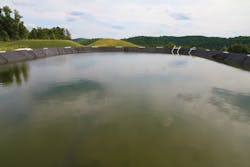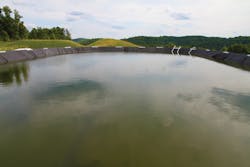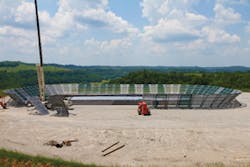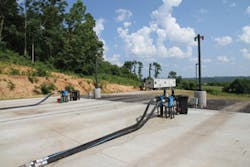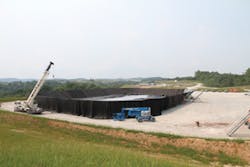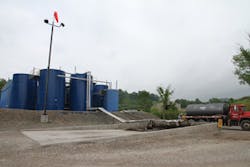Water management critical in Appalachia
GreenHunter Resources focuses on innovative solutions
Anthony D. Andora, Andora Corp. Santa Monica, Calif.
The combining of horizontal drilling and fracture stimulation technology has revolutionized the oil and gas industry. Giant shale formations, ranging from the Bakken oil shale and the Marcellus natural gas shale, have helped America move one step closer toward energy independence. In fact, the US Energy Information Administration estimates that the United States is currently on track to become energy independent by the year 2020.
One sector of the industry that has been a major benefactor from the surge in unconventional oil and natural gas drilling is the fluid logistics/water treatment sector. For every unconventional well that is drilled, some form of water solutions is required. Whether it's managing flow-back water, transporting and disposing water, or simply treating it for recycle and reuse, water solutions are a necessity.
One company quick to the forefront of this sector is GreenHunter Resources. Founded by Gary C. Evans and managed by a team of industry experts with more than 100 years of combined oil and gas experience, the team has developed innovative solutions for both large and small exploration companies treating their fluids logistics/water treatment needs.
In less than three years, GreenHunter Resources, which mainly operates in the Marcellus and Utica shales in the Appalachian region of the eastern United States, has grown into the largest total water solutions company in the region. How this relatively small company has come to dominate the region, however, is no secret. Management's ability to identify cost-efficient solutions is a key factor.
For example, GreenHunter decided to leverage its expertise in the oil and gas sector and convert pre-existing uneconomic oil and gas wells into disposal wells. Most water solutions companies drill costly new disposal wells to manage water. GreenHunter's solution results in a cost savings of approximately $1 million per well. In addition, while many companies operate disposal wells that manage less than 1,000 barrels of water per day, the typical GreenHunter disposal well can easily manage more than 2,000 barrels of water and up to 3,000 barrels of water per day. The management team is currently developing other water solutions for logistics and treatment that will result in additional cost savings to producers.
Headquartered along the Ohio River, GreenHunter Resources is currently expanding its transportation options to include not only trucking but also barging and pipeline access. The company is working with legislators in Washington DC to help establish a policy for barging brine water down navigable waterways. Once in place, a single barge could potentially displace about 270 trucks, removing them from crowded roads and freeways and resulting in significant savings for operating companies. It also greatly reduces the potential for traffic accidents on our nation's highways.
While GreenHunter established its foundation in disposal wells and transport, the simultaneous launch of its Frac-Cycle® high-solids water treatment service created a higher margin segment that offered a less-expensive alternative to E&P companies that would otherwise need to solidify this material and send it to landfills. Company management noted that the Frac-Cycle® system paid for itself before it was up and running because of a sizeable volume sent by its first customer.
Most recently, GreenHunter designed and has marketed a patent-pending and proprietary above-ground storage tank for the impoundment of water for frac operations – the MAG Tank™. This product is a cost-effective replacement to the use of earthen impoundments and traditional frac tanks that saves E&P companies 50% per barrel or more.
GreenHunter's client list includes ExxonMobil, Chevron, CNX/CONSOL, and Noble Energy, as well as a host of smaller E&P companies. While GreenHunter does share a close relationship with Magnum Hunter Resources due to Gary C. Evans' executive position with both companies, Magnum Hunter represents less than 10% of GreenHunter's total corporate revenue. In fact, the only two companies representing more than 10% of GreenHunter's revenues in 2013 were Chevron at 12% and Anadarko at 11%.
GreenHunter says its customers understand the consequences of not getting things done right the first time around. They know that if an E&P company hires a water treatment company that mismanages water solutions, or worse yet, engages in unlawful environmental practices, it's not just the water treatment company that attracts the government's attention, consequences, and hefty fines, but also they themselves can be placed under investigation. GreenHunter's experience and superior environmental track record with state agencies and abundant resources allow the company to always remain in compliance with state and federal regulations and has contributed to the company's success and growth in the industry.
Today, GreenHunter has a total of nine disposal wells. By year-end 2014, the company estimates that it will have a total of 16 to 18 disposal wells in commercial operation. As GreenHunter COO Kirk Trosclair points out, "While the increased demand will require us to drill new salt water disposal wells at a higher cost than our initial nine conversion wells, the economics of operating in the Appalachian Basin still provide a compelling upside."
Trosclair notes that GreenHunter's experienced operating team can continue to deliver significant value for its clients using both newly drilled wells and conversion wells, while simultaneously, generating economic project returns. As the company begins to transport an increasing percentage of its water hauling via barge and pipeline, the win-win scenario for both GreenHunter and its clients will become even more evident.
Funding is anticipated to come from several sources, including internally generated cash-flow, as well as the recent divestiture of non-core assets in Oklahoma and South Texas. In the past 12 months, GreenHunter has generated more than $12 million from the divestiture of non-core assets in both the Eagle Ford shale and the Mississippi Lime play.
When asked what prompted these divestitures, Evans notes that it's all about return on capital. He notes that while the Eagle Ford and Mississippi Lime are economic, they aren't comparable with the Appalachian Basin.
Evans said, "In the Appalachian Basin, we can generate $2.50 to $3.50 per barrel compared to the Eagle Ford and Mississippi Lime where we were averaging about $0.50 per barrel of water disposed. In addition, the growth prospects in the Appalachian are enormous. In the first quarter of 2014, salt-water disposal volumes increased from approximately 471,000 barrels to approximately 927,000 barrels or approximately 97%."
The increased growth in volumes further led to GreenHunter's first quarter of positive EBITDA in 2014.
Increased growth prospects have generated increased buying activity and have also attracted Wall Street's attention. Noteworthy sell-side analysts now covering GreenHunter Resources include: Michael Hoffman with Wunderlich Securities, Evan Richert with Sidoti & Company, Gerard Sweeney with Boenning & Scattergood Inc., and Philip L. Dodge of Noble Financial. Most recently, Noble Financial initiated coverage on GreenHunter Resources with a "Buy" recommendation citing strong revenue growth in the company's salt water disposal operations, margin improvement in transportation services, and additional benefits from introduction of a creative salt water storage line. Over the past three months, GreenHunter's common stock is up 70%.
As the oil and natural gas industry marches toward energy independence and as increased requests from the international community call for natural gas exports from the United States, one can expect activity in the Marcellus and Utica shale plays to continue to increase to meet this new demand. The increased activity in these areas will require more robust and sophisticated water logistics and treatment solutions, which should benefit innovative companies like GreenHunter.
About the Author
Anthony D. Andora is an independent consultant in the oil and gas industry. With more than 15 years' experience Andora has consulted, advised, and represented small-, mid-, and large-cap companies on a variety of issues ranging from detailed focus groups, advertising initiatives, investor relations, and national media campaigns. He has co-produced, developed, and placed content in/on CNBC, FOX Business News, Bloomberg Television, The Wall Street Journal, Barron's, and Oil & Gas Financial Journal. He can be reached at [email protected].
